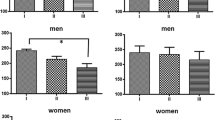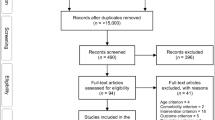Abstract
Objective of the study was to replicate in adults our previous findings of decreased heart rate and normal endocrine responses to stress in autistic children and to elucidate the discrepancy between autonomic and endocrine stress responses by including epinephrine, norepinephrine, oxytocin and vasopressin measurements. Ten autistic spectrum disorder (ASD) adults were compared to 14 healthy controls in their response to a psychosocial stressor (public speaking). ASD patients showed decreased heart rate, but normal cortisol responses, consistent with our prior findings in children. No differences in norepinephrine, epinephrine, oxytocin or vasopressin responses to stress were found. However, in contrast to previous findings in low functioning autistic children, ASD adults showed increased basal oxytocin levels, which may be related to developmental factors.







Similar content being viewed by others
References
Althaus, M., Mulder, L. J., Mulder, G., Aarnoudse, C. C., & Minderaa, R. B. (1999). Cardiac adaptivity to attention-demanding tasks in chidren with pervasive developmental disorder, not otherwise specified (PDD-NOS). Biological Psychiatry, 46, 799–809.
Bouvard, M. P., Leboyer, M., Launay, J.-M., Recasens, C., Plumet, M.-H., Waller-Perotte, D., Tabuteau, F., Bondoux, D., Dugas, M., Lensing, P., & Panksepp, J. (1995). Low-dose naltrexone effects on plasma chemistries and clinical symptoms in autism: A double-blind, placebo-controlled study. Psychiatry Research, 58, 191–201.
Carter, C. S. (1998). Neuroendocrine perspectives on social attachment and love. Psychoneuroendocrinology, 23, 779–818.
Cohen, S., Hamrick, N., Rodriguez, M. S., Feldman, P. J., Rabin, B. S., & Manuck, S. B. (2000). The stability of and intercorrelations among cardiovascular, immune, endocrine, and psychological reactivity. Annals of Behavioral Medicine, 22, 171–179.
Corona, R., Dissanayake, C., Arbelle, S., Wellington, P., & Sigman, M. (1998). Is affect aversive to young children with autism? Behavioral and cardiac responses to experimenter distress. Child Development, 69, 1494–1502.
Croonenberghs, J., Delmeire, L., Verkerk, R., Lin, A., Meskal, A., Neels, H., Van der Planken, M., Scharpe, S., Deboutte, D., Pison, G., & Maes, M. (2000). Peripheral markers of serotonergic and noradrenergic function in post-pubertal, Caucasian males with autistic disorder. Neuropsychopharmacology, 22, 275–283.
De Wied, D., Diamant, M., & Fodor, M. (1993). Central nervous system effects of the neurohypophyseal hormones and related peptides. Frontiers in Neuroendocrinology, 14, 251–302.
Dimsdale, J. E., & Moss, J. (1980). Short-term catecholamine response to psychological stress. Psychosomatic Medicine, 42, 493–497.
Green, L., Fein, D., Modahl, C., Feinstein, C., Waterhouse, L., & Morris, M. (2001). Oxytocin and autistic disorder: Alterations in peptide forms. Biological Psychiatry, 50, 609–613.
Groden, J., Cautela, J., Prince, S., & Berryman, J. (1994). The impact of stress and anxiety on individuals with autism and developmental disabilities. In: E. Schopler, & G. B. Mesibov (Eds.), Behavioral issues in autism (pp. 177–194). New York: Plenum Press.
Hollander, E., Novotny, S., Hanratty, M., Yaffe, R., DeCaria, C. M., Aronowitz, B. R., & Mosovich, S. (2003). Oxytocin infusion reduces repetitive behaviors in adults with autistic and Asperger’s disorders. Neuropsychopharmacology, 28, 193–198.
Insel, T. R. (1997). A neurobiological basis of social attachment. American Journal of Psychiatry, 154, 726–735.
Insel, T. R., O’Brien, D., & Leckman, J. (1999). Oxytocin, vasopressin, and autism: Is there a connection? Biological Psychiatry, 45, 145–157.
Insel, T. R. & Young, L. J. (2000). Neuropeptides and the evolution of social behavior. Current Opinion in Neurobiology, 10, 784–789.
Jansen, L. M. C., Gispen-de Wied, C. C., Van der Gaag, R. J., & Van Engeland, H. (2003). Differentiation between autism and Multiple Complex Developmental Disorder in the response to psychosocial stress. Neuropsychopharmacology, 28, 582–590.
Lake, C. R., Ziegler, M. G., & Murphy, D. L. (1977). Increased norepinephrine levels and decreased dopamine-beta-hydroxylase activity in primary autism. Archives of General Psychiatry, 34, 553–556.
Launay, J.-M., Bursztejn, C., Ferrari, P., Dreux, C., Braconnier, A., Zarifian, E., Lancrenon, S., & Fermanian, J. (1987). Catecholamines metabolism in infantile autism: A controlled study of 22 autistic children. Journal of Autism and Developmental Disorders, 17, 333–347.
Leboyer, M., Bouvard, M. P., Launay, J.-M., Tabutau, F., Waller, D., Dugas, M., Kerdelhue, B., Lensing, P., & Panksepp, J. (1992). Brief report: A double-blind study of naltrexone in infantile autism. Journal of Autism and Developmental Disorders, 22, 309–319.
Legros, J.-J. (2001). Inhibitory effect of oxytocin on cortisotrope function in humans: Are vasopressin and oxytocin ying-yang neurohormones? Psychoneuroendocrinology, 26, 649–655.
Maher, K. R., Harper, J. F., Macleay, A., & King, M. G. (1975). Peculiarities in the endocrine respons to insulin stress in early infantile autism. The Journal of Nervous and Mental Disease, 161(3), 180–184.
Martineau, J., Barthelemy, C., Jouve, J., Muh, J.-P., & LeLord, G. (1992). Monoamines (serotonin and catecholamines) and their derivates in infantile autism: age-related changes and drug effects. Developmental Medicine and Child Neurology, 34, 593–603.
Martineau, J., Herault, J., Petit, E., Guerin, P., Hameury, L., Perrot, A., Mallet, J., Sauvage, D., LeLord, G., & Muh, J.-P. (1994). Catecholaminergic metabolism and autism. Developmental Medicine and Child Neurology, 36, 688–697.
Minderaa, R. B., Anderson, G. M., Volkmar, F. R., Akkerhuis, G. W., & Cohen, D. J. (1994). Noradrenergic and adrenergic functioning in autism. Biological Psychiatry, 36, 237–241.
Modahl, C., Green, L., Fein, D., Morris, M., Waterhouse, L., Feinstein, C., & Levin, H. (1998). Plasma oxytocin levels in autistic children. Biological Psychiatry, 43, 270–277.
Neumann, I. D., Kromer, S. A., Toschi, N., & Ebner, K. (2000). Brain oxytocin inhibits the (re)activity of the hypothalamo-pituitary-adrenal axis in male rats: involvement of hypothalamic and limbic brain regions. Regulatory Peptides, 96, 31–38.
Nijsen, M. J. M. A., Croiset, G., Diamant, M., Stam, R., Delsing, D., De Wied, D., & Wiegant, V. M. (1998). Conditioned fear-induced tachycardia in the rat; vagal involvement. European Journal of Pharmacology, 350, 211–222.
Novotny, S. L., Hollander, E., Allen, A., Aronowitz, B. R., DeCaria, C., Cartwright, C., & Yaffe, R. (2000). Behavioral response to oxytocin challenge in adult autistic disorders. Biological Psychiatry, 47, 159S.
Porges, S. W. (2001). The polyvagal theory: Phylogenetic substrates of a social nervous system. International Journal of Psychophysiology, 42, 123–146.
Romero, L. M., & Sapolsky, R. M. (1996). Patterns of ACTH secretagog secretion in response to psychological stimuli. Journal of Neuroendocrinology, 8, 243–258.
Sheehan, D. V., Lecrubier, Y., Harnett-Sheehan, K., Amorim, P., Janavs, J., Weiller, E., Hergueta, T., Baker, R., & Dunbar, G. (1998). The Mini International Neuropsychiatric Interview (M.I.N.I.): The development and validation of a structured diagnostic psychiatric interview. Journal of Clinical Psychiatry, 59(suppl. 20), 22–33.
Tordjman, S., McBride, P. A., Hertzig, M. E., Snow, M. E., Thompson, S. M., Anderson, G. M., Hall, L. M., Ferrari, P., & Cohen, D. J. (1998). Plasma beta-endorphin, adrenocorticotropin hormone, and cortisol in autism. Journal of Child Psychology and Psychiatry, 38, 705–715.
Van Dam-Baggen, C. M. J. & Kraaimat, F. W. (1987). IOA—Inventarisatielijst Omgaan met Anderen. Lisse: Swets & Zeitlinger.
Van der Ploeg, H. M., Defares, P. B., & Spielberger, C. D. (1981). Handleiding bij de zelf-beoordelingsvragenlijst. Lisse: Swets and Zeitlinger BV.
Van Londen, L., Goekoop, J. G., Zwinderman, A. H., Lanser, J. B., Wiegant, V. M., & De Wied, D. (1998). Neuropsychological performance and plasma cortisol, arginine vasopressin and oxytocin in patients with major depression. Psychological Medicine, 28, 275–284.
Wechsler, D. (1986). Wechsler Intelligence Scale for Children—revised NL. Lisse: Swets & Zeitlinger.
Yamazaki, K., Saito, Y., Okada, F., Fujieda, T., & Yamashita, I. (1975). An application of neuroendocrinological studies in autistic children and Heller’s syndrome. Journal of Autism and Childhood Schizophrenia, 5(4), 323–332.
Acknowledgments
This study was supported by a fellowship from the Hersenstichting Nederland (Dutch Brain Foundation, grant number H00.13). The authors wish to thank Henk Spierenburg for his assistance in the oxytocin and vasopressin assays, and André Klompmakers for his assistance in the catecholamine assays.
Author information
Authors and Affiliations
Corresponding author
Rights and permissions
About this article
Cite this article
Jansen, L.M.C., Gispen-de Wied, C.C., Wiegant, V.M. et al. Autonomic and Neuroendocrine Responses to a Psychosocial Stressor in Adults with Autistic Spectrum Disorder. J Autism Dev Disord 36, 891–899 (2006). https://doi.org/10.1007/s10803-006-0124-z
Published:
Issue Date:
DOI: https://doi.org/10.1007/s10803-006-0124-z




